

You should query the database first.
First you should select an experiment from the query results page.
You should select a snapshot from experiment first.

News and updates
In the hierarchical universe, galaxy interactions and mergers play a fundamental role in galaxy formation and evolution, assembling mass and reshaping galaxies. They can re-arrange angular momentum and produce spectacular phenomena, such as tidal tails and ripples, polar rings, kinematically decoupled cores, and frequently star formation bursts.
Understanding and interpreting all these phenomena is an ambitious task, complicated by the vast range of physical parameters involved: mass ratio between the interacting galaxies, geometrical and orbital parameters, type and mass distribution of the progrenitors, etc.
With the GalMer Project, we have chosen a statistical approach to the problem, by performing and analysing thousands of simulations of interacting pairs, with initial conditions relevant to all epochs of the universe, at different redshifts.
The aim of this considerable computational effort is to provide to the scientific community a very large set of colliding pairs, and the evolution of the corresponding galaxies in isolation as well, in order to study statistically the impact that interactions and mergers have on the chemodynamical evolution of galaxies. This website provides a user-friendly access to the database, together with tools to perform on-the-fly analysis of the simulations.
Here you can see the pre-recorded 7-min long tutorial demonstrating many of the features provided by the GalMer web-site.
If you use this database in your research, please cite I. Chilingarian, P. Di Matteo, F. Combes, A.-L. Melchior, B. Semelin 2010 (A&A in press)
Get Registred ClientsWe model interactions among galaxies of different morphologies, from ellipticals to late-type spirals. The adopted galaxy models consist of a spherical non-rotating dark-matter halo, which may or may not contain a stellar and a gaseous disc and, optionally, a central non-rotating bulge.
For each galaxy type, the halo and the optional bulge are modelled as Plummer spheres, with characteristic masses MB and MH and characteristic radii rB and rH. The stellar and gaseous discs follow the Myamoto-Nagai density profile, with masses M* and Mg and vertical and radial scale lengths given, respectively, by h* and a*, and hg and ag.
For the initial models of the disc galaxies, we chose an initial Toomre parameter for the stellar disc Qstar = 1.2, and two different initial ones for the gas component, Qgas = 0.3 and Qgas = 1.2, in order to reproduce, at least partially, the variety of parameters found in real galaxies.
The database contains interacting galaxy pairs of different mass ratios (1:1, 1:2, 1:10), involving a giant galaxy (gE0 for a giant-like elliptical, gS0 for a giant-like lenticular, gSa for a giant-like Sa spiral, gSb for a giant-like Sbc spiral and gSd for a giant-like Sd spiral), interacting with:
- either another giant galaxy;
- or an intermediate-mass galaxy (hereafter iE0, iS0, iSa, iSb and iSd), having a total mass half that of the giant's mass;
- or a dwarf galaxy (hereafter dE0, dS0, dSa, dSb and dSd) whose total mass is ten times smaller that that of the giant galaxy.
We also provide the evolution of the corresponding galaxies in isolation, in order to compare secular processes and those caused by the interaction.
The complete Hubble sequence of the galaxy models is given in Fig.1.
The initial rotation curves of the modelled disc galaxies are shown in Fig.2.
The complete list of all the parameters of model galaxies is given in Table 1.
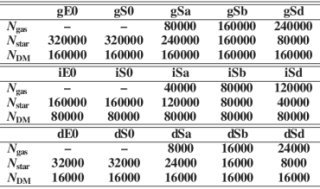 |
Table 2. Particle numbers for giant-intermediate (mass ratio 1:2) and giant-dwarf (mass ratio 1:10) interactions. For giant-giant interactions, all numbers in the top table should be divided by 4. |
Each galaxy is made up of a total number of particles NTOT distributed among gas, stars and dark matter. Gas particles are actually hybrid particles, characterized by two mass values: one corresponds to the gravitationalmass and stays unchanged during the whole simulation, and the other is the gas content of the particule, decreasing or increasing according to the local star formation rate and mass loss ( see Chilingarian et al. 2010, Sect. 3.1, Eq.1). When the gas fraction is below a certain threshold, the particle is transformed into a star particle, and the remaining gas mass is distributed over neighbouring gas particles. For giant-giant interactions, each galaxy is made up of a total number of particles of NTOT=120000, distributed among gas, stars and dark matter, depending on the morphology. For giant-intermediate and giant-dwarf interactions, we increased by a factor 4 the total number of particles in the giant galaxy. This allowed to improve the spatial resolution of the simulations and, in particular, to maintain a high enough numerical resolution for the smaller galaxy (NTOT=240000 and NTOT=48000 for the intermediate and dwarf galaxy, respectively; Table 2).
For each pair of interacting galaxies, we performed several simulations, varying the galaxies orbital initial conditions (initial orbital energy E and angular momentum L) and taking into account both direct and retrograde orbits (Tables 3, 4 and 5). For each interacting pair, we kept the disc (when present) of one of the two galaxies in the orbital plane (i1 = 0 deg), and varied the inclination i2 of the companion disc, considering: i2 = 0 deg, i2 = 45 deg, i2 = 75 deg, and i2 = 90 deg. For giant-dwarf interactions, we also consider a more generic case, with i1 = 33 deg, and i2 = 130 deg. See Fig. 3 and Table 6 for the definition of the angles and their initial values.
To model galaxy evolution, we employed a Tree-SPH code, in which gravitational forces are calculated using a hierarchical tree method (Barnes & Hut 1986) and gas evolution is followed by means of smoothed particle hydrodynamics (SPH, Lucy 1977; Gingold & Monaghan 1982). Gravitational forces are calculated using a tolerance parameter θ = 0.7 and include terms up to the quadrupole order in the multipole expansion. A Plummer potential is used to soften gravitational forces, with same softening lengths for all particle types. We assume a softening length ε = 280 pc for giant-giant interactions, and ε = 200 pc for the giant-intermediate and giant-dwarf runs. The code (evaluation of the gravitational forces, implementation of the SPH technique and star formation modelling) was described in Semelin & Combes (2002), where a standard validation test for this type of codes (the collapse of an initially static, isothermal sphere of self-gravitating gas) was also presented. In our present study, we adopted an isothermal gas phase for the GalMer runs. Other tests are presented in Di Matteo et al. (2008).
Smoothed Particle Hydrodynamics (SPH) is a Lagrangian technique in which the gas is partitioned into fluid elements represented by particles, which obey equations of motion similar to the collisionless component, but with additional terms describing pressure gradients, viscous forces and radiative effects in gas. To capture shocks a conventional form of the artificial viscosity is used, with parameters α = 0.5 and β = 1.0 (Hernquist & Katz 1989). To describe different spatial dynamical ranges, SPH particles have individual smoothing lengths hi, calculated in such a way that a constant number of neighbours lies within 2hi. The giant-giant simulations were performed using a number of neighbours Ns ∼ 15; for the giant-intermediate and giant-dwarf interactions Ns ∼ 50. The gas is modelled as isothermal, with a temperature Tgas = 104K. The equations of motion are integrated using a leapfrog algorithm with a fixed time step of t = 5 × 105yr.
We provide the WEB-based access to the complete set of the GalMer simulations. The metadata of the simulations are stored in the PostgreSQL object-relational database management system (ORDBMS). The internal structure of the database represents the relational serialisation of the SimDB Data Model. The datasets (individual snapshots) are stored as binary FITS files.
The first release of the GalMer data contains:
We also provide the C API for the project (I/O of the simulation snapshots, extracting star formation history for individual hybrid particles, generation of mass- and luminosity-weighted maps of physical quantities, generation of spectra of stellar populations, etc.)
We provide a set of on-line services which can be used to analyse the results of the GalMer simulations and/or prepare additional data for futher research.
 icon, or displayed and analysed in the TopCat tool, where it is sent using
PLASTIC application messaging
protocol.
icon, or displayed and analysed in the TopCat tool, where it is sent using
PLASTIC application messaging
protocol.
A number of the IVOA standards have been implemented in our project. Some of them have been already approved, others are in the development phase now.
Several other VO standards will be implemented in the GalMer project in the near future
Presently, the comprises (in alphabetical order):
This is a selection of the most recent publications based on the GalMer database.
For a complete list see the References section.
|
The slowing down of galaxy disks in dissipationless minor mergers Qu, Y., Di Matteo, P., Lehnert, M., van Driel, W., Jog, C. J., 2010, A&A, in press | |
We have investigated the impact of dissipationless minor galaxy mergers on the angular momentum of the remnant. Our simulations cover a range of initial orbital characteristics and the system consists of a massive galaxy with a bulge and disk merging with a much less massive (one-tenth or one-twentieth) gasless companion which has a variety of morphologies (disk- or elliptical-like) and central baryonic mass concentrations. During the process of merging, the orbital angular momentum is redistributed into the internal angular momentum of the final system; the internal angular momentum of the primary galaxy can increase or decrease depending on the relative orientation of the orbital spin vectors (direct or retrograde), while the initially non-rotating dark matter halo always gains angular momentum. The specific angular momentum of the stellar component always decreases independent of the orbital parameters or morphology of the satellite, the decrease in the rotation velocity of the primary galaxy is accompanied by a change in the anisotropy of the orbits, and the ratio of rotation speed to velocity dispersion of the merger remnant is lower than the initial value, not only due to an increase in the dispersion but also to the slowing -down of the disk rotation. We briefly discuss several astrophysical implications of these results, suggesting that minor mergers do not cause a random walk process of the angular momentum of the stellar disk component of galaxies, but rather a steady decrease. Minor mergers may play a role in producing the large scatter observed in the Tully-Fisher relation for S0 galaxies, as well as in the increase of the velocity dispersion and the decrease in v/σ at large radii as observed in S0 galaxies. |
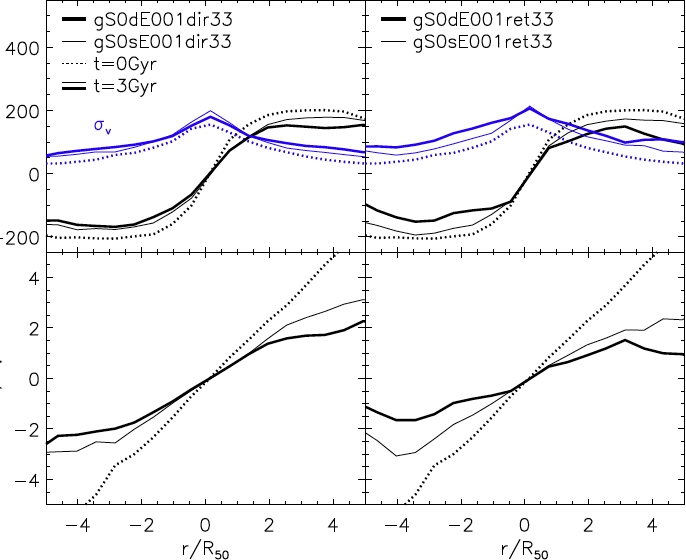 Upper panels: Line-of-sight velocities and velocity dispersions of stars in the initial gS0 model galaxy (dotted lines) and in the final remnant of a 10:1 (thick solid lines) and a 20:1 (thin solid lines) merger. Direct encounters are shown in the left panel, retrograde encounters on the right. Lower panels: v/σ ratio of the initial gS0 model (dotted lines) and of the final remnant of the 10:1 (thick solid lines) and 20:1 (thin solid lines) mergers shown in the upper panels. Distances are in multiples of R50. From Qu et al., 2010, A&A, in press. |
|
Chilingarian, I. V., Novikova, A. P., Cayatte, V., Combes, F., Di Matteo, P., Zasov, A. V. 2009, A&A 504, 389 | |
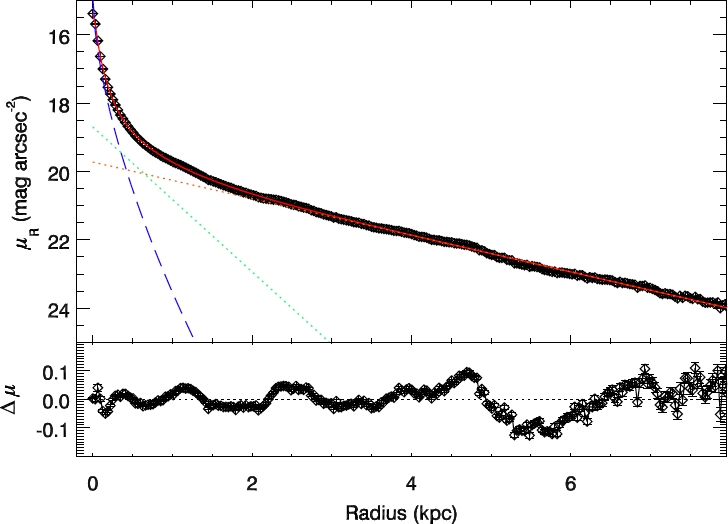 The three-component NGC 6340 light profile decomposition. The top panel displays the brightness profile shown with black diamonds, and the three components represented by the blue dashed, green and red dotted lines for inner S´ersic, internal and external exponential profiles correspondingly. The bottom panel shows the fitting residuals. From Chilingarian et al., 2009, A&A, 504, 389. |
Lenticular galaxies are believed to form by a combination of environmental effects and secular evolution. We study the nearby disc-dominated S0 galaxy NGC 6340 photometrically and spectroscopically to understand the mechanisms of S0 formation and evolution in groups. Methods: We use SDSS images to build colour maps and the light profile of NGC 6340, which we decompose using a three-component model including Sérsic and two exponential profiles. We also use Spitzer Space Telescope archival near-infrared images to study the morphology of regions containing warm interstellar medium and dust. Then, we re-process and re-analyse deep long-slit spectroscopic data for NGC 6340, applying a novel sky subtraction technique and recover its stellar and gas kinematics, distribution of age and metallicity with the NBursts full spectral fitting. We obtain the profiles of internal kinematics, age, and metallicity out to >2 half-light radii. The three structural components of NGC 6340 are found to have distinct kinematic and stellar population properties. We see a kinematic misalignment between inner and outer regions of the galaxy. We confirm the old metal-rich centre and a wrapped inner gaseous polar disc (r ∼ 1 kpc) having weak ongoing star formation, counter-rotating in projection with respect to the stars. The central compact pseudo-bulge of NGC 6340 looks very similar to compact elliptical galaxies. In accordance with the results of numerical simulations, we conclude that the properties of NGC 6340 can be explained as the result of a major merger of an early-type galaxy and a spiral galaxy that occurred about 12 Gyr ago. The intermediate exponential structure might be a triaxial pseudo-bulge formed by a past bar structure. The inner compact bulge could be the result of a nuclear starburst triggered by the merger. The inner polar disc appeared recently, 1/3-1/2 Gyr ago, as a result of another minor merger or cold gas accretion. |
|
Generation of rotationally dominated galaxies by mergers of pressure-supported progenitors Di Matteo, P., Jog, C. J., Lehnert, M. D., Combes, F., Semelin, B. 2009, A&A 501, L9 | |
Through the analysis of a set of numerical simulations of major mergers between initially non-rotating, pressure-supported progenitor galaxies with a range of central mass concentrations, we have shown that: (1) it is possible to generate elliptical-like galaxies, with v/σ > 1 outside one effective radius, as a result of the conversion of orbital- into internal-angular momentum; (2) the outer regions acquire part of the angular momentum first; (3) both the baryonic and the dark matter components of the remnant galaxy acquire part of the angular momentum, the relative fractions depending on the initial concentration of the merging galaxies. For this conversion to occur the initial baryonic component must be sufficiently dense and/or the encounter should take place on an orbit with high angular momentum. Systems with these hybrid properties have recently been observed through a combination of stellar absorption lines and planetary nebulae for kinematic studies of early-type galaxies. Our results are in qualitative agreement with these observations and demonstrate that even mergers composed of non rotating, pressure-supported progenitor galaxies can produce early-type galaxies with significant rotation at large radii. |
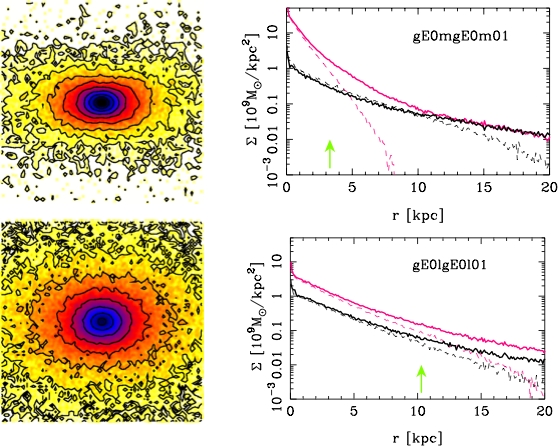 Morphological characteristics of two remnants of pressure-supported, initially non-rotating galaxies. Top panels: (Left) Projected density map of the remnant of the gE0mgE0m01 encounter (progenitors with high concentrations); (Right) Surface density profile of the baryonic (red color) and dark matter component (black color) of the remnant (solid line) and its progenitor galaxy (dashed line). The green arrows indicate the half mass radius (r50) of the baryonic component. Bottom panels: Same as top panels, but progenitors with relatively low concentrations (gE0lgE0l01). The remnant whose progenitors have high concentrations is characterized by a v/σ ratio greater than 1 outise r50. From Di Matteo et al, 2009, A&A, 501, L9. |
|
On the survival of metallicity gradients to major dry mergers Di Matteo, P., Pipino, A., Lehnert, M. D., Combes, F., Semelin, B. 2009, A&A 499, 427 | |
Using a large suite of galaxies with a variety of concentrations and metallicity gradients, we study the evolution of non-dissipative (dry) equal mass mergers. Our purpose in generating these simulations is to explore how the metallicity gradient in dry mergers depends on the structure and metallicity gradients of the galaxies involved in the merger. Specifically, we would like to answer: Could dry mergers lead to metallicity gradients as observed in elliptical galaxies in the local Universe? Do dry mergers always lead to a flattening of the initial (i.e., pre-merger) gradient? From this modeling, we conclude that: The ratio of the remnant and the initial galaxy slopes span a wide range of values, up to values greater than 1 (with values greater than one resulting only when companions have gradients twice the progenitor). For a merger between two ellipticals having identical initial metallicity slopes (i.e., equal companion and galaxy slopes), the metallicity profile of the remnant flattens, with a final gradient about 0.6 times the initial one. Ellipticals can maintain their original pre-merger metallicity gradient if the companion slope is sufficiently steep. The amount of flattening neither depends on the characteristics of the orbit of the progenitors or on their initial concentration. Given the diversity in outcomes of the mergers, we conclude that dry mergers do not violate any observational constraints on the systematic characteristics of metallicity gradients in local ellipticals. In fact, dry mergers may be important within the context of the results of our simulations and may explain the large scatter in gradients for massive ellipticals and the relative paucity of massive ellipticals with no or shallow metallicity gradients. |
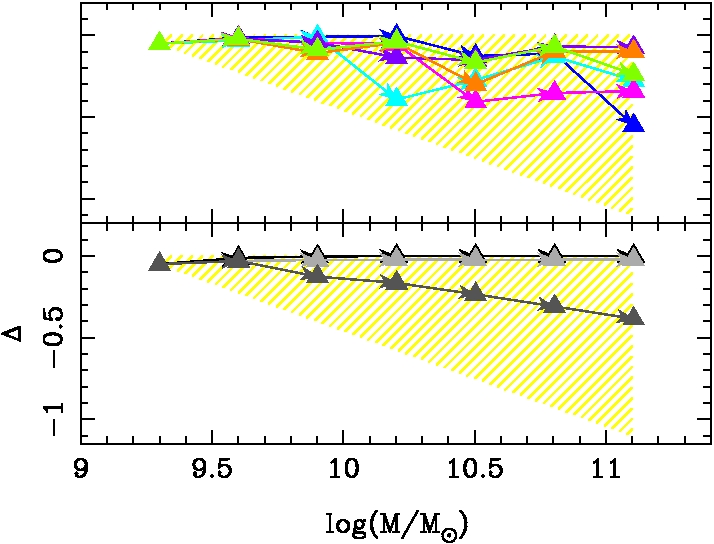 Evolution of metallicity gradients through a sequence of major dry mergers. The initial elliptical galaxy has log(M/MSun)=9.3 and Δ=-0.05. (Upper panel) Different colors correspond to different merging histories, with companion gradients randomly distributed in the shaded area (cf. Fig.2, right panel, in Ogando et al. 2005). (Lower panel) Different colors correspond to different merging histories, with companion gradients always equal to zero (black triangles), to the initial galaxy gradient (light gray triangles), and to the maximum slope allowed for a given mass, i.e., lower edge in the shaded area (dark gray triangles). From Di Matteo et al., 2009, A&A, 499, 427. |
|
Di Matteo, P., Bournaud, F., Martig, M., Combes, F., Melchior, A.-L., Semelin, B. 2008, A&A 492, 31 | |
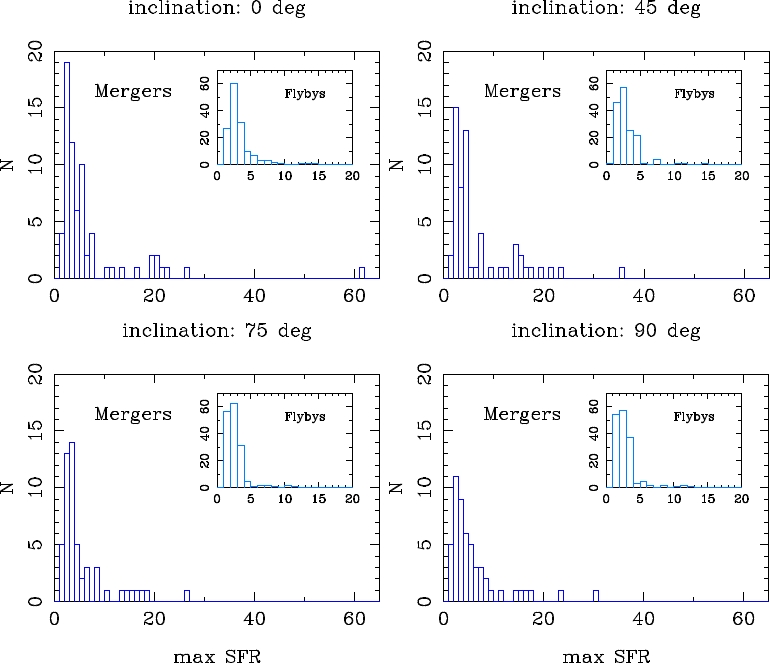 Histograms of the maximum SFR (relative to the isolated case) for mergers. Flybys are shown for comparison in the small window inserted in the figure. From left to right: histograms relative to encounters with i2= 0 deg, i2= 45 deg, i2= 75 deg and i2= 90 deg, respectively. From Di Matteo et al. 2008, A&A 492, 31. |
We investigate the intensity enhancement and the duration of starburst episodes triggered by major galaxy interactions and mergers. We analyze two large statistical datasets of numerical simulations. These have been obtained using two independent and different numerical techniques to model baryonic and dark matter evolution that are extensively compared for the first time. One is a Tree-SPH code, the other one is a grid-based N-body sticky-particles code. We show that, at low redshift, galaxy interactions and mergers in general trigger only moderate star formation enhancements. Strong starbursts where the star formation rate is increased by a factor greater than 5 are rare and found only in about 15% of major galaxy interactions and mergers. Merger-driven starbursts are also rather short-lived, with a typical duration of activity of a few 108 yr. These conclusions are found to be robust, independent of the numerical techniques and star formation models. At higher redshifts where galaxies contain more gas, gas inflow-induced starbursts are neither stronger nor longer than their local counterparts. In turn, the formation of massive gas clumps, results of local Jeans instability that can occur spontaneously in gas-rich disks or be indirectly favored by galaxy interactions, could play a more important role in determining the duration and intensity of star formation episodes. |
|
Old stellar counter-rotating components in early-type galaxies from elliptical-spiral mergers Di Matteo, P., Combes, F., Melchior, A.-L., Semelin, B. 2008, A&A 477, 437 | |
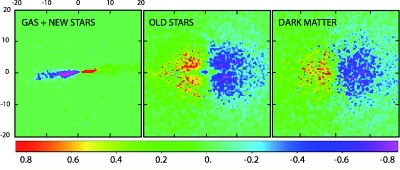 Line-of-sight velocity maps of gas (left panel), old stars (central panel) and dark matter (right panel) of the remnant of an elliptical-spiral merger. The maps are evaluated 1Gyr after the coalescence of the two galaxies. Each side of the plot is 40 kpc in size. Velocities are in units of 100 km/s. From Di Matteo et al. 2008, A&A 477, 437. |
We use numerical simulations to investigate the possibility of forming counter-rotating old stellar components by major mergers between an elliptical and a spiral galaxy. We show that counterrotation can appear both in dissipative and dissipationless retrograde mergers, and it is mostly associated to the presence of a disk component, which preserves part of its initial spin. In turn, the external regions of the two interacting galaxies acquire part of the orbital angular momentum, from the action of tidal forces exerted on each galaxy by the companion. |
|
Star formation efficiency in galaxy interactions and mergers: a statistical study Di Matteo, P., Combes, F., Melchior, A.-L., Semelin, B. 2007, A&A 468, 61 | |
We investigate the enhancement of star formation efficiency in galaxy interactions and mergers by numerical simulations of several hundred galaxy collisions. All morphological types along the Hubble sequence are considered in the initial conditions of the two colliding galaxies, with varying bulge-to-disk ratios and gas mass fractions. Different types of orbits are simulated, direct and retrograde, according to the initial relative energy and impact parameter, and the resulting star formation history is compared to that occuring in the two galaxies when they are isolated. Our principal results are (1) retrograde encounters have greater star formation efficiency (SFE) than direct encounters, (2) the amount of gas available in the galaxy is not the main parameter governing the SFE in the burst phase, (3) there is a negative correlation between the amplitude of the star forming burst and the tidal forces exerted per unit of time, which is due to the large amount of gas dragged outside the galaxy by tidal tails in strong interactions, (4) globally, the Kennicutt-Schmidt law is seen to apply statistically for isolated galaxies, interacting pairs and mergers, (5) enhanced star formation occurs essentially in nuclear starbursts, triggered by inward gas flows driven by non-axisymmetries in the galaxy disks. Direct encounters develop more pronounced asymmetries than retrograde ones. Based on these statistical results we derive general laws for the enhancement of star formation in galaxy interactions and mergers, as a function of the main parameters of the encounter. |
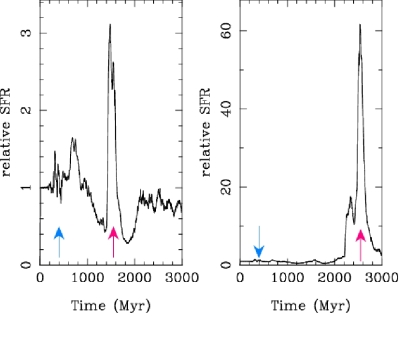 Star formation rate, versus time, for some galaxy mergers. The SFR is normalized to that of the corresponding isolated galaxies. The blue arrows indicate the first pericenter passage between the two galaxies, and the red arrows the merger epoch. From Di Matteo et al. 2007, A&A 468, 61 |
to be added
|
| |||||||||||||||||||||||||||||||||||||||||||||||